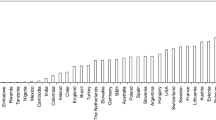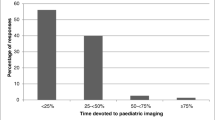Abstract
Paediatric radiology requires dedicated equipment, specific precautions related to ionising radiation, and specialist knowledge. Developing countries face difficulties in providing adequate imaging services for children. In many African countries, children represent an increasing proportion of the population, and additional challenges follow from extreme living conditions, poverty, lack of parental care, and exposure to tuberculosis, HIV, pneumonia, diarrhoea and violent trauma. Imaging plays a critical role in the treatment of these children, but is expensive and difficult to provide. The World Health Organisation initiatives, of which the World Health Imaging System for Radiography (WHIS-RAD) unit is one result, needs to expand into other areas such as the provision of maintenance servicing. New initiatives by groups such as Rotary and the World Health Imaging Alliance to install WHIS-RAD units in developing countries and provide digital solutions, need support. Paediatric radiologists are needed to offer their services for reporting, consultation and quality assurance for free by way of teleradiology. Societies for paediatric radiology are needed to focus on providing a volunteer teleradiology reporting group, information on child safety for basic imaging, guidelines for investigations specific to the disease spectrum, and solutions for optimising imaging in children.














Similar content being viewed by others
References
Chen S, Ravallion M. The developing world is poorer than we thought, but no less successful in the fight against poverty, Policy Research Working Paper 4703, World Bank, August 2008. http://econ.worldbank.org/external/default/main?pagePK=64165259&piPK=64165421&theSitePK=469372&menuPK=64216926&entityID=000158349_20100121133109. Accessed 5 October 2010
2007 Human Development Report (HDR), United Nations Development Program, November 27, 2007 / 2008, p.25. http://hdr.undp.org/en/media/HDR_20072008_EN_Complete.pdf. Accessed 5 October 2010
State of the World’s Children, 2005, UNICEF. http://www.unicef.org/sowc05/english/sowc05.pdf. Accessed 5 October 2010
Patton GC, Coffey C, Sawyer SM, Viner RM, Haller DM, Bose K, Vos T, Ferguson J, Mathers CD (2009) Global patterns of mortality in young people: a systematic analysis of population health data. Lancet 374:881–892
The World Factbook. https://www.cia.gov/library/publications/the-world-factbook/geos/mz.html. Accessed 5 October 2010
World Health Organisation. http://www.who.int/countries/. Accessed 5 October 2010
Zanoni B (2005) Epidemiology of HIV in Southern Africa. Pediatr Radiol 39:538–540
Bryce J, Boschi-Pinto C, Shibuya K, Black R (2005) WHO Child Health Epidemiology Reference Group. Lancet 365:1147–1152
Zar HJ (2006) Global paediatric pulmonology: out of Africa. Paediatr Respir Rev 7:S226–S228
WHO AIDS epidemic update UNAIDS/09.36E / JC1700E (English original, November 2009). http://data.unaids.org/pub/Report/2009/JC1700_Epi_Update_2009_en.pdf. Accessed 5 October 2010
Women and Children in South Africa. http://www.unicef.org/southafrica/children.html. Accessed 5 October 2010
Adams LV (2004) Childhood tuberculosis in the developing world. Pediatr Ann 33:685–690
WHO Report. Global tuberculosis control. http://www.who.int/tb/publications/global_report/2009/pdf/report_without_annexes.pdf. Accessed 5 October 2010
Ng’ambi TM, Borgstein ES (2005) Epidemiology of paediatric trauma admission at Queen Elizabeth Cebtral Hospital, Blantyre. Malawi Med J 17:5–6
Osinaike B, Amanor-Boadu S. Paediatric trauma admissions in a Nigerian ICU. Internet Journal of Emergency and Intensive Care Medicine. http://www.ispub.com/ostia/index.php?xmlPrinter=true&xmlFilePath=journals/ijeicm/vol9n2/icu.xml. Accessed 5 October 2010
Stuckler D, King L, Robinson H, McKee M (2008) WHO's budgetary allocations and burden of disease: a comparative analysis. Lancet 372:1563–1569
Dept. of Int. devt.(2001) Access to water in developing countries. http://www.parliament.uk/documents/post/pn178.pdf. Accessed 19 December 2009
Mozambique.http://www.citizen.org/cmep/Water/cmep_Water/reports/safrica/. Accessed 19 December 2009
Palmer PES (1985) The WHO basic radiological system. Radiography 53:170–178
Krupinski EA (1996) Clinical Assessment of dry laser-processed film versus traditional wet-processed film with computer tomography, magnetic resonance imaging, and ultrasound. Acad Radiol 3:855–858
Kozilainin, H (2001) Rehabilitation of hospital infrastructure in a developing country. World Hospital Health Serv 37:28–8,34,36
US Army medical department centre and school. X-ray film processing.http://milmed.pmk.ac.th/MD0954%20X-RAY%20FILM%20PROCESSING.pdf. Accessed 3 January 2010
Korolev A I (1990) Equipment for fast radiography with diffusion-transfer photographic materials. (translated from Russian) Meditsinskaya Tekhnika1:25–27
McHugh K (2002) Essential imaging facilities. In: Southall DP, Coulter B, Ronald C, Nicholson S, Parke S (eds) International child health care: a practical manual for hospitals worldwide. Child Advocacy International. BMJ Books, London
Advice on Donating Equipment Overseas. http://idcsig.org/page6.html. Accessed 22 December 2009
Malkin AA (2007) Design of healthcare technologies for the developing world. Annu Rev Biomed Eng 9:567–587
Kitonyi JM (1993) The basic radiological system experience in Kenya. East Afr Med J 70:793–796
The World Health Imaging System for Radiography—WHIS-RAD: simply perfect. World health Organisation, Geneva, 2004
What Is The Climate, Average Temperature/ Weather In Mozambique? http://www.climatetemp.info/mozambique/.Aceesed 21 December 2009
Brederhofs J, Raceveneau (1982) Radiological services throughout the world. Diagn Imaging 51:121–133
Health care in South Africa http://www.southafrica.info/about/health/health.htm Accessed: 3 January 2010
Urinary tract infection in children: diagnosis, treatment and long-term management. NICE clinical guideline 54. http://www.nice.org.uk/nicemedia/pdf/CG54NICEguideline. Accessed 5 October 2010
Frost and Sullivan (2008) Strategic Analysis of the Medical Imaging Market in Kenya. http://www.pharmaceutical-market-research.com/publications/medical_devices/strategic_analysis_medical_imaging_market_kenya.html. Accessed 5 October 2010
Kawooya M (2008) Role Extension for the Radiographer in the New Millennium. http://www.isrrt.org/images/isrrt/09H50%20DR%20M%20KAWOOYA%20RM%201A%20SESSION%201%20FRIDAY.pdf. Accessed 5 October 2010
www.medpages.co.za. Accessed 5 October 2010
Strachan M (2009) Imbalance between public and private radiological services in the Western Cape Of South Africa. Dissertation University of Stellenbosch, South Africa
Hanson GP (1988) Essential X-ray services: the basic radiological system (BRS). Trop Geogr Med 40(4):s576–s578
Health systems http://www.who.int/topics/health_systems/en/.Accessed 5 January 2010
Simpson PD (1998) A study of chest radiography with mobile units. Br J Radiol 71:640–645
Wootton R (2001) Telemedicine and developing countries—successful implementation will require a shared approach. J Telemed Telecare S1:1–6
http://www.swinfencharitabletrust.org/. Accessed 5 October 2010
http://www.healthnet.org/. Accessed 5 October 2010
Pyke J, Hart M, Popov V et al (2007) A tele-ultrasound system for real-time medical imaging in resource limited settings. In: Conference Proceedings of the IEEE 2007:3094–3097
http://www.teleradiologie-sans-frontieres.org/. Accessed 7 October 2010
Szot A, Jacobson FL, Munn S, Jazayeri D, Nardell E, Harrison D, Drosten R, Ohno-Machado L, Smeaton LM, Fraser HS (2004) Diagnostic accuracy of chest X-rays acquired using a digital camera for low-cost teleradiology. Int J Med Inform 73:65–73
Corr P, Couper I, Beningfield SJ, Mars M (2000) A simple telemedicine system using a digital camera. J Telemed Telecare 6:233–236
http://www.nighthawkradiology.net/. Accessed 5 October 2010
http://www.doctorswithoutborders.org/news/article.cfm?id=4157. Accessed 5 October 2010
Baylor College of Medicine. International Paediatric AIDS Initiative. http://www.Bayloraids.org/programs/Swaziland/outreach.php. Accessed 5 October 2010
Rotarians assess need for WHIS-RAD imaging system in Zimbabwe. http://www.auntminnie.com/index.asp?Sec=nws&sub=rad&pag=dis&ItemId=53004Accessed 3 January 2010
Rudd PD (2003) The development of radiographer reporting 1965–1999. Radiography 9:7–12
Brandt A, Andronikou S, Wieselthaler N, Louw B, Kilborn T, Dekker G, Bertelsman J, Dreyer C (2007) Accuracy of radiographer reporting of paediatric brain CT. Pediatr Radiol 37:291–296
Cowan I, Smith T, Nakabea P, Ajibulu O, Hennessy O (2007) WHO/RANZCR/ISRRT. Developing the image interpretation skills of South Pacific radiographers: a joint WHO/RANZCR/ISRRT project. Australas Radiol 51:527–531
Andronikou S, Vanhoenacker FM, De Backer AI (2009) Advances in imaging chest tuberculosis: blurring of differences between children and adults. Clin Chest Med 30:717–744, viii
Williams JR (2000) Ethics and human rights in South African medicine. CMAJ 162:1167–1170
Sullivan P (1999) Canada a prime destination as MDs flee South Africa. CMAJ 160:1615–1616
Truth and Reconciliation Commission of South Africa Report. Cape Town: TRC/Juta; 1998. vol IV, chapt V. p. 120. www.polity.org.za/govdocs/commissions/1998/trc/index.htm. Accessed August 2010
Price M (1986) Health care as an instrument of apartheid policy in South Africa. Health Policy Plan 1:158–170
Author information
Authors and Affiliations
Corresponding author
Rights and permissions
About this article
Cite this article
Andronikou, S., McHugh, K., Abdurahman, N. et al. Paediatric radiology seen from Africa. Part I: providing diagnostic imaging to a young population. Pediatr Radiol 41, 811–825 (2011). https://doi.org/10.1007/s00247-011-2081-8
Received:
Revised:
Accepted:
Published:
Issue Date:
DOI: https://doi.org/10.1007/s00247-011-2081-8




